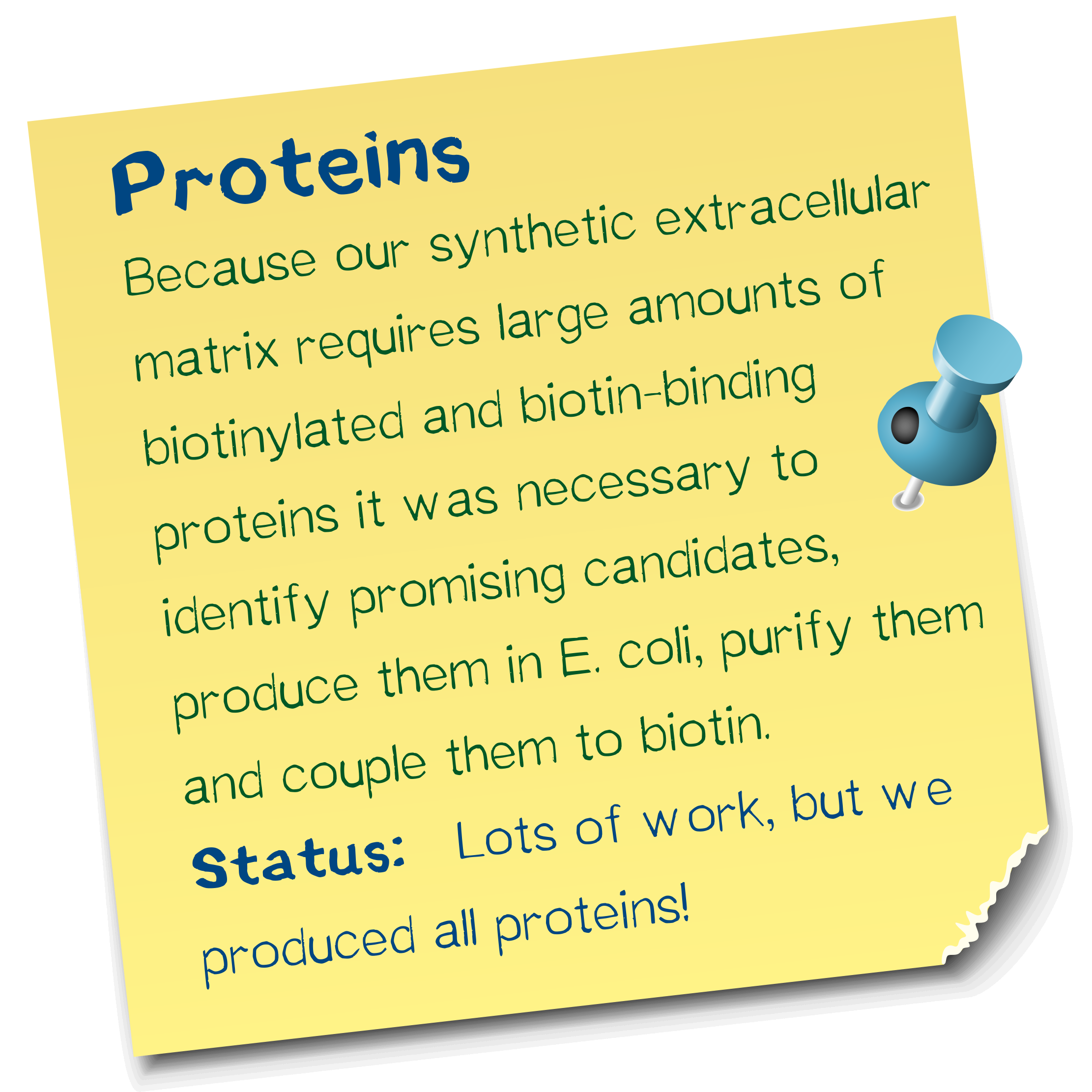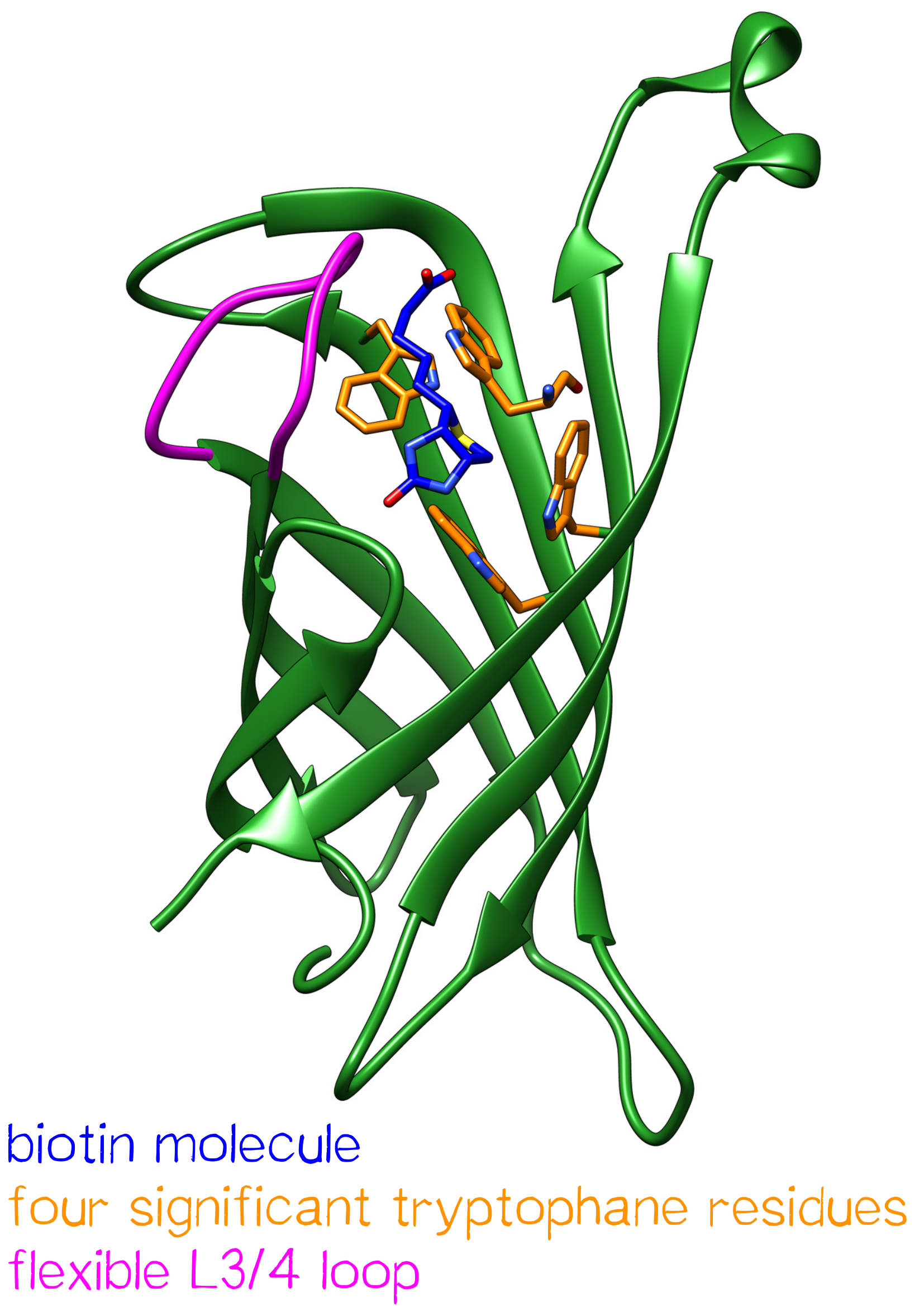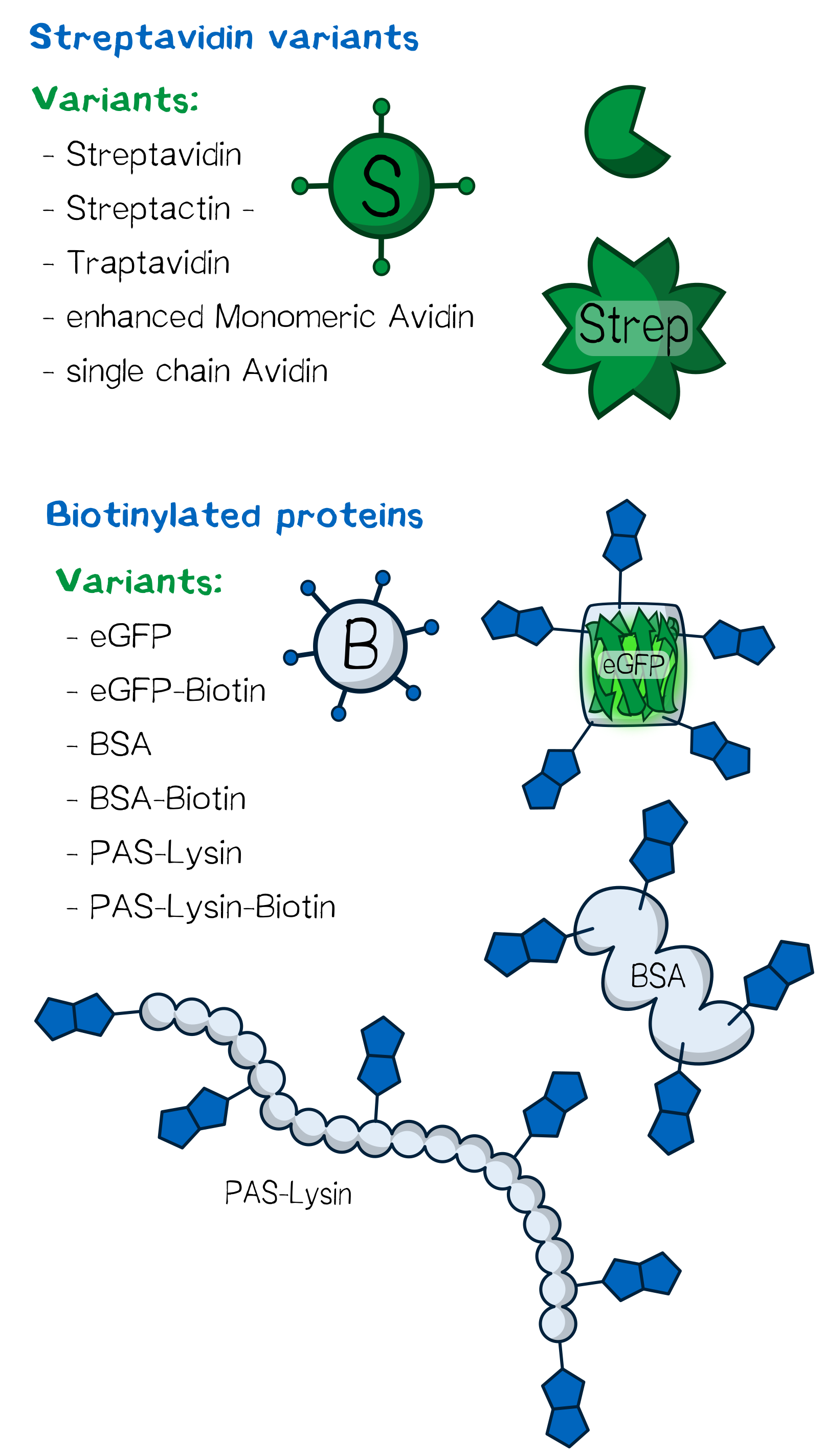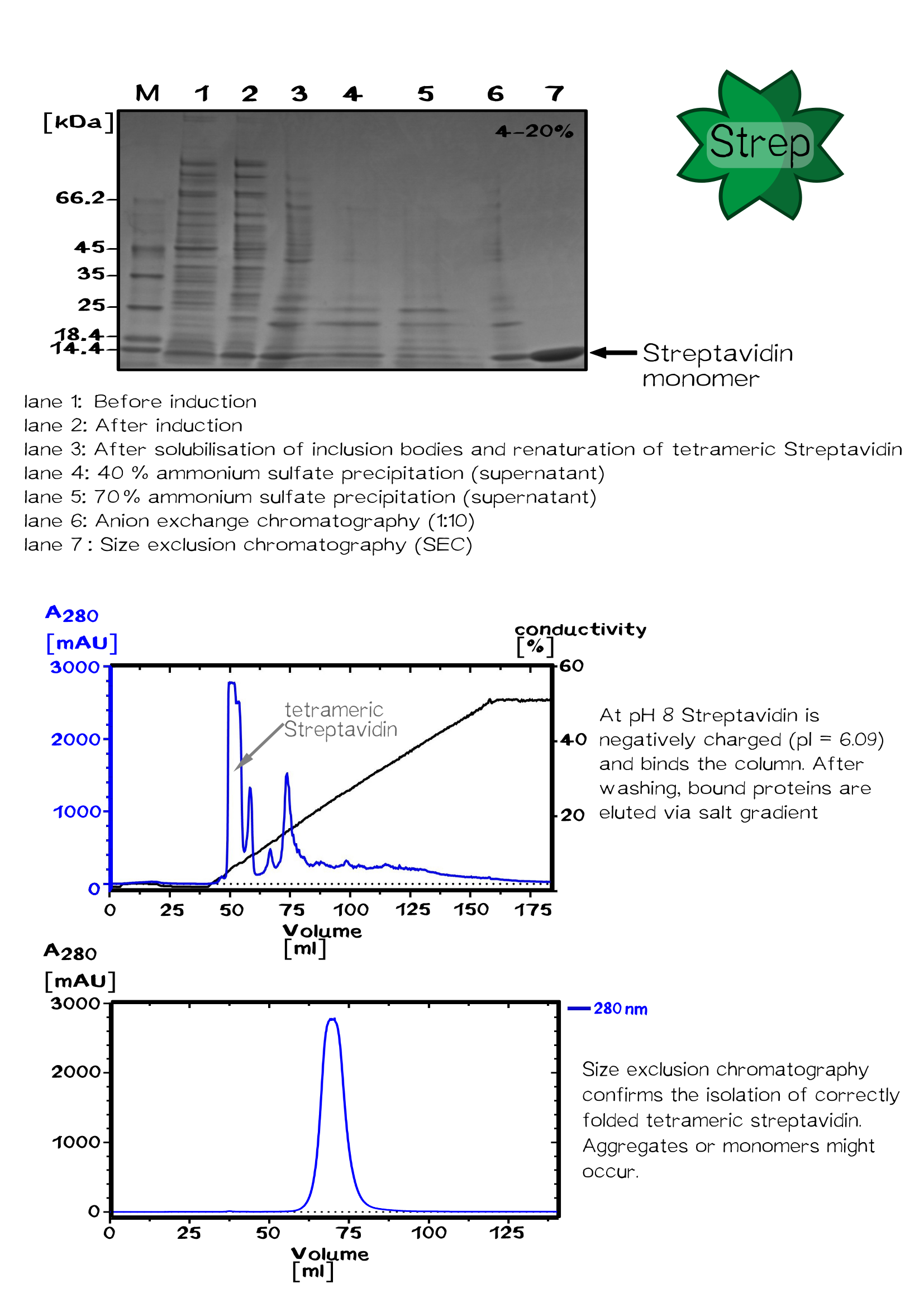(→Streptavidin Fermentation) |
(→Streptavidin Fermentation) |
||
| Line 135: | Line 135: | ||
=Streptavidin Fermentation= | =Streptavidin Fermentation= | ||
<html><p><video width=49% style="float:left; margin-top : 15px"; margin-bottom : 15px; controls preload:"auto"> | <html><p><video width=49% style="float:left; margin-top : 15px"; margin-bottom : 15px; controls preload:"auto"> | ||
| − | <source src="https://static.igem.org/mediawiki/2016/ | + | <source src="https://static.igem.org/mediawiki/2016/0/08/Fermentation.mp4" type="video/mp4"> |
Your browser does not support this video player.</video> | Your browser does not support this video player.</video> | ||
<br> | <br> | ||
Revision as of 00:01, 18 October 2016
Interaction of biotin and Streptavidin leads to a pseudopolymerization
For cross-linking cells immediately upon printing them, we utilize the extraordinary strength of the biotin-streptavidin interaction. The cells express a receptor which allows them to present a biotin molecule or a streptavidin variant on their cell surface (see Receptor).
The tetrameric streptavidin protein in the printing solution is able to cross-link the biotinylated cells and thus make them form a stable network upon printing. In order to adjust intercellular distances, a biotinylated linker peptide containing regularly spaced biotinylated lysine residues is used.
Streptavidin and Biotin: The strongest non-covalent affinity in nature
Streptavidin is a tetrameric protein with a molecular weight of 52.8 kDa[1] and was originally isolated from Streptomyces avidinii. Each subunit is able to bind a single biotin molecule. This specific, non-covalent bond with a unique femtomolar dissociation constant (KD = 10-15 M-1) is one of the strongest known biological interactions. Antibodies, in comparison, have dissociation constants in the range of 10-7 – 10-11 M-1 - being less affine by a factor of a million.[2]
One subunit of streptavidin is organized as an eight stranded antiparallel beta sheet of coiled polypeptide chains which form a hydrogen bonded barrel with extended hydrogen loops[3] (see figure 2).
The biotin binding pocket primarily consists of aromatic and polar side chains, which interact with the hetero atoms of biotin.
Due to the high specificity and affinity of the interaction, Streptavidin is often used for protein-purification via affinity chromatography and as a detection and coupling reagent in daily lab routine.[4]
The rapid and very strong linkage between the two binding partners results from the creation of multiple hydrogen bonds as well as Van der Waals interactions upon binding. Comparing the Apo-state of streptavidin and the streptavidin-biotin complex hereby shows several structural differences of the binding pocket.
The ordering of a flexible surface polypeptide loop results in burying the biotin molecule in its pocket. Without biotin, the L3/4 loop is disordered and does not give clear electron density, while it closes upon biotin binding.[5]
Important for the high energetical barrier required for dissociation are biotin-tryptophan contacts in the binding pocket. There are four significant tryptophan residues involved in the binding site. Three of those (Trp79, Trp92 and Trp108) are lined up in one section. Trp120 binds the biotin molecule from an adjacent subunit and displays a much larger influence in binding free energy.[6]
Moreover the hydrogen bonding network and Van der Waals forces show great influence in binding free energy. Compared to similar hydrogen bonding donors and acceptors of other protein-ligand systems the hydrogen bonding of Streptavidin to the ureido oxygen of biotin is remarkably high.
Streptavidin variants and homologs
Several streptavidin variants were expressed, purified and tested in order to determine how their specific properties influence the printing processes. An overview of the different physical properties of the Streptavidin variants we used are shown below. For further information about experimental characterisation visit Results.
Table 1: Physical properties and characteristics of the Streptavidin variants that were used for the project.
| protein | residues | molecular weight monomer [kDa] | molecular weight tetramer [kDa] | theoretical pI | pI (IEF) | extinction coefficient (monomer, A280) [M-1 cm-1] |
| Streptavidin wt | 126 | 13.20 | 52.80 | 6.09 | 41940 | |
| Traptavidin | 126 | 13.13 | 52.52 | 5.14 | 41940 | |
| Strep-Tactin | 126 | 13.24 | 52.52 | 8.32 | 41940 | |
| enhanced monomeric Avidin | 138 | 15.22 | / | 5.91 | 35075 | |
| single chain Avidin | 567 | 61.53 | / | 9.84 | 94460 |
Traptavidin - increased mechanical strength of biotin binding
Being a streptavidin derivate with two point mutations that increase its affinity (S52G, R53D), traptavidin shows a 10-times lower dissociation constant compared to the wildtype (KD=~10-16 M). Moreover, the tetramer has an improved thermostability and thus remains more functional at higher temperatures(TM~10 °C higher)[7]. In contrast to streptavidin, the Traptavidin L3/4 loop (residues 45-50) does not change its conformation upon binding biotin. The binding pocket is already closed and lacks flexibility. The loss of a structural change is thought to lower the entropic cost of binding and therefore decreases the koff-value as well as the dissociation constant.
Strep-Tactin - a Strep-tag binding protein
The sequence of the Strep-affinity tag is eight residues long and can be genetically fused N- or C-terminal to recombinant protein. Using the Strep-tag's interaction with Strep-Tactin for affinity chromatography enables a simple and rapid one step-purification and provides great yields in protein- or protein complex purification. The strep-tagged protein binds Strep-Tactin, which is immobilized on the column matrix. After removing host proteins by washing, the target protein can be eluted with desthiobiotin, which binds the Strep-Tactin several orders of magnitude stronger. Over the years both, the Strep-tag and the Streptavidin were optimized resulting in Strep-tag II (amino acid sequence WSHPQFEK) binding to Strep-Tactin. [8]
Enhanced Monomeric Avidin (eMA)- engineered for applications like molecular labelling
Due to the monovalent nature of eMA, unwanted cross-linking of biotin conjugats can not occur.
Since Streptavidin binding pockets depend on one residue from a adjacent subunit, binding affinity of a single subunit is decreased (KD = 10-7 to 10-9 M-1). eMA consists of a monomerized Rhizavidin dimer, which contains a disulfid bond in the binding site restraining the protein and forming a rigid binding pocket[9].
Single chain avidin (scAvidin)
asdfghm
Production and purification of streptavidin
Figure 4: Overview Streptavidin production and isolation
The minimal Streptavidin wildtype gene is cloned on a pSA plasmid. The transcription is under control of a T7-promoter. The E.coli BL-R (DE3) strain codes the T7-polymerase under the control of a lacUV5 promotor, which can be induced by Isopropyl β-D-1-thiogalactopyranoside (IPTG).
A shaking flask with 2 L LB medium supplemented with ampicillin is inoculated 1:40 with a 50 ml preculture grown at 30 °C over night.
The bacterial culture shakes at 37 °C for at least four hours until its optical density reaches 0.6 and protein production is induced with 1 mM IPTG. After 4 hours the cells can be harvested by centrifugation (5000 rpm for 30 min).
The cell pellet is resuspended in a 20 mM Tris/HCl buffer (500 mM NaCl, pH 8) and Homogenization can be proceeded with French press or PANDA. The cell lysate is centrifuged at 11500 rpm for 30 min to separate the inclusion bodies in the pellet from the soluble proteins of the supernatant.
The inclusion bodies consist of aggregated and misfolded protein, those are denaturated with 6 M guanidinium chloride and centrifuged at 15000 rpm for 15 minutes.
The aggregations in the pellet are discarded and the supernatant is added slowly into a high volume of PBS (30 ml PBS for 1 ml protein solution) and incubated over night. Guanidinium chloride is diluted and proteins are able to fold correctly. The solution is centrifuged again (11500 rpm for 30 min) to remove aggregates.
The Streptavidin purification is proceeded by fractionally ammonium sulfate precipitation. After each precipitation step the solution is incubated without stirring for few hours and centrifuged at 11500 rpm for 30 minutes afterwards.
First precipitation step is 40 % saturation (1.75 M). Streptavidin remains soluble, the pellet can be discarded. After centrifugation the ammonium sulfate saturation is increased up to 70 % (3.37 M), Streptavidin is no longer soluble and precipitates.
The pellet is resuspended in a 50 % saturated ammonium sulfate solution (2.25 M), streptavidin again precipitates. After centrifugation the pellet is resuspended in 1x PBS buffer.
As a result the solution contains only those proteins, which precipitate between 40 % and 50 % ammonium sulfate saturation. One last centrifugation at 15000 rpm for 30 minutes removes insoluble impurities.
The solution is dialysed against 20 mM Tris/HCl buffer without salt (pH 8). Streptavidin has an isoelectric point of 6.09, therefore it is negatively charged in its buffer and a positively charged ResQ column is used for ion exchange chromatography. An increasing salt concentration of the buffer causes fractional elution of protein.
Streptavidin monomers, tetramers and aggregates can be identified by gel filtration with a sephacryl column.
After sterile filtration, a UV/VIS spectrum of the solution is measured in order to determine its concentration.[10]
The production of Traptavidin and Strep-Tactin is analogue. Enhanced monomeric Avidin is isolated via IMAC.
Streptavidin Fermentation
=Biotinylated PAS-lysine for cross linking=
The PAS-lysine sequence is 201 residues long and primarily consists of the three amino acids Proline, Alanine and Serine. This hydrophilic and uncharged polymer is very good soluble. Ten lysine residues occur in the sequence and allow chemically biotinylation at the terminal amino group.
The cells are harvested (5000 rpm, 30 minutes) after five hours shaking at 37 °C and resuspended in 20 mM Tris/HCl buffer with 500 mM salt, pH 8. Homogenization is conducted by French press or PANDA. SUMO PAS-lysine is very good soluble, after centrifugation at 11500 rpm for 30 minutes it is located in the supernatant, the pellet can be discarded.
SUMO PAS-lysine has the property to remain native even at high temperatures, where most protein denaturate. Heating the solution up to 70 °C for 20 minutes and centrifugation afterwards removes nearly all other proteins.
The solution is dialysed against IMAC buffer (50 mM sodium dihydrogen phosphate and 500 mM salt, ph 7.5) and loaded on a chromatography column packed with nickel. After washing away impurities, the addition of imidazole results in elution of the SUMO PAS-lysine.
The SUMO domain has no further use and is cleaved off by the SUMO-protease ULP. Another IMAC chromatography separates the PAS-lysine from SUMO domain, which binds specifically to the column. PAS lysine can be identified in the flow through via UV absorption. Because PAS-lysine does not contain aromatic residues, its absorption at 280 nm is very low, while the absorption at 225 nm (amid bondage) is average.
The proper fractions are pooled and the solution is dialysed against 20 mM Tris/HCl buffer with 500 mM salt, pH 8. The linker molecule can now be biotinylated in a molar excess of 10 or 20. After incubation over night, dialysis removes biotin molecules which did not bind the PAS-lysine linker.
{{LMU-TUM_Munich_html_end}}
- ↑ Determined via http://www.expasy.org/
- ↑ Weber, P. C., Ohlendorf, D. H., Wendoloski, J. J., & Salemme, F. R. (1989). Structural origins of high-affinity biotin binding to streptavidin. Science, 243(4887), 85. ISO 690
- ↑ Weber, P. C., Ohlendorf, D. H., Wendoloski, J. J., & Salemme, F. R. (1989). Structural origins of high-affinity biotin binding to streptavidin. Science, 243(4887), 85.
- ↑ Schmidt, T. G., & Skerra, A. (2007). The Strep-tag system for one-step purification and high-affinity detection or capturing of proteins. Nature protocols, 2(6), 1528-1535. ISO 690
- ↑ Weber, P. C., Ohlendorf, D. H., Wendoloski, J. J., & Salemme, F. R. (1989). Structural origins of high-affinity biotin binding to streptavidin. Science, 243(4887), 85.
- ↑ Stayton, P. S., Freitag, S., Klumb, L. A., Chilkoti, A., Chu, V., Penzotti, J. E., ... & Stenkamp, R. E. (1999). Streptavidin–biotin binding energetics. Biomolecular engineering, 16(1), 39-44.
- ↑ Weber, P. C., Ohlendorf, D. H., Wendoloski, J. J., & Salemme, F. R. (1989). Structural origins of high-affinity biotin binding to streptavidin. Science, 243(4887), 85.
- ↑ Schmidt, T. G., & Skerra, A. (2007). The Strep-tag system for one-step purification and high-affinity detection or capturing of proteins. Nature protocols, 2(6), 1528-1535.
- ↑ Lee, J. M., Kim, J. A., Yen, T. C., Lee, I. H., Ahn, B., Lee, Y., ... & Jung, Y. (2016). A Rhizavidin Monomer with Nearly Multimeric Avidin‐Like Binding Stability Against Biotin Conjugates. Angewandte Chemie International Edition, 55(10), 3393-3397.
- ↑ Skerra, A., Gebauer, M., Schönfeld, D., Schmelz, E. (2007). Skript zu "Fortgeschrittenenpraktikum Proteinchemie"







